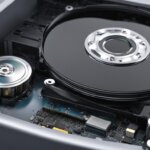Table of Contents
Defragmentation, also known as defragging or defrag, is the process of rearranging the data on a storage medium, such as a hard disk drive (HDD), for efficient storage and access. It involves consolidating fragmented files so that all the related pieces are aligned together. This process can improve the performance and speed of a computer or laptop. Fragmentation occurs when files are scattered throughout the hard drive, making it slower to access and write data.
By defragmenting the hard drive, files are organized and space is freed up, resulting in improved speed and performance. Most operating systems have built-in disk defragmentation tools, and the frequency of defragging depends on the usage of the hard drive.
Why is Defragmentation Needed?
Defragmentation is crucial to address and resolve issues such as slow speeds, freeze-ups, and extended boot times that commonly plague computer systems. When files become fragmented, meaning they are scattered and disorganized throughout the hard drive, it leads to a decrease in performance and difficulties in accessing data effectively.
Think of fragmented files as a jumbled-up load of laundry, with socks, shirts, and pants all mixed together. Trying to find a specific item becomes time-consuming and frustrating. Defragmentation is like sorting and organizing this laundry pile, ensuring that all the related pieces are aligned together for easier access.
By defragmenting the hard drive, the system reorganizes and stores the data in a more efficient manner, resulting in improved performance and faster data access. This process essentially rearranges the scattered pieces, allowing the computer to retrieve data more effectively, avoiding the delays and slow speeds caused by fragmented files.
Furthermore, defragmentation helps free up unused space on the hard drive. As files are consolidated and rearranged, it creates larger contiguous blocks of free space, making the storage medium more efficient. This optimized disk space not only enhances the overall speed and performance of the computer but also extends the lifespan of the device by reducing the wear and tear on mechanical and spinning components.
Overall, defragmentation is an essential maintenance task that every computer user should perform regularly to ensure optimal system performance, eliminate slow speeds, prevent freeze-ups, and reduce extended boot times.
How to Perform Defragmentation
Most contemporary operating systems, including Windows 11, come equipped with built-in disk defragmentation tools that can automatically perform the defragmentation process. However, if you prefer to manually defragment your hard drive, follow these simple steps:
1. Go to the search bar on the Start menu and type “defrag”.
2. Select the “Defragment and Optimize Drives” option from the search results.
3. Choose the drive that you want to defragment from the list and click on “Optimize”.
By following these steps, you can defragment your hard drive and optimize its performance. It’s worth noting that modern versions of Windows and macOS usually have built-in optimization tools, so manual defragmentation may not be necessary, especially if your computer is constantly on. However, if you routinely shut down your device after each use, running the defragmentation utility once a month is recommended to ensure optimal performance.
Keep in mind that disk defragmentation tools and optimization tools help improve the efficiency and speed of your computer by organizing fragmented files and freeing up space on the hard drive. Whether you choose to use manual defragmentation or rely on built-in tools, regular maintenance is essential for maintaining your computer’s performance.
FAQ
What is defragmentation?
Defragmentation, also known as defragging or defrag, is the process of rearranging the data on a storage medium, such as a hard disk drive (HDD), for efficient storage and access. It involves consolidating fragmented files so that all the related pieces are aligned together.
Why is defragmentation needed?
Defragmentation is needed to solve and mitigate problems such as slow speeds, freeze-ups, and extended boot times of a computer. When files are fragmented, meaning they are scattered throughout the hard drive, it can lead to slower performance and difficulty in accessing data. Defragmentation consolidates these fragmented files so that all the related pieces are aligned together, similar to organizing a jumbled-up load of laundry.
How to perform defragmentation?
Most contemporary operating systems have built-in disk defragmentation tools that can automatically perform the defragmentation process. For example, on a Windows 11 machine, you can manually defragment a hard drive by following these steps: Go to the search bar on the Start menu and type defrag. Select the Defragment and Optimize Drives option. Choose the drive that needs to be defragmented and click on Optimize. It is important to note that modern versions of Windows and macOS usually have built-in optimization tools, so manual defragmentation may not be necessary, especially if the computer is constantly on. However, if the device is routinely shut down after each use, running the defragmentation utility once a month is recommended to ensure optimal performance.












